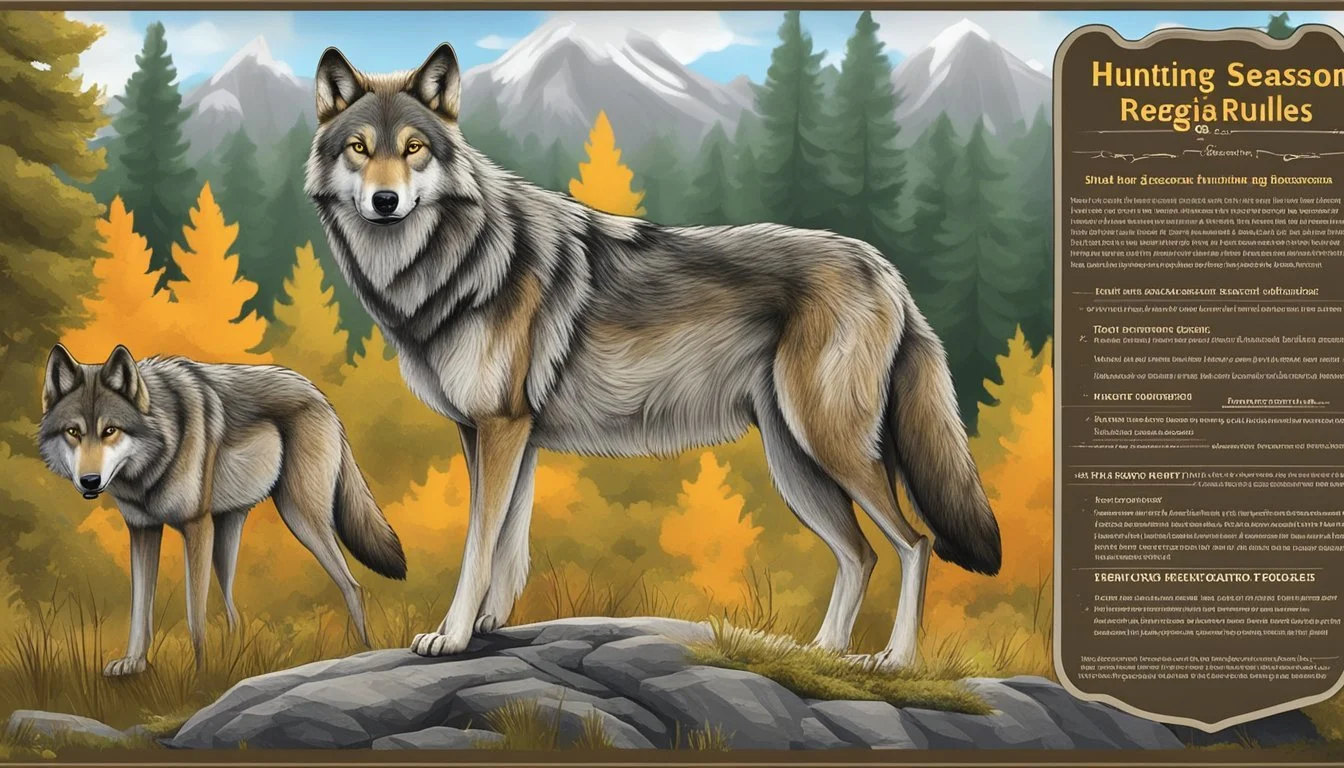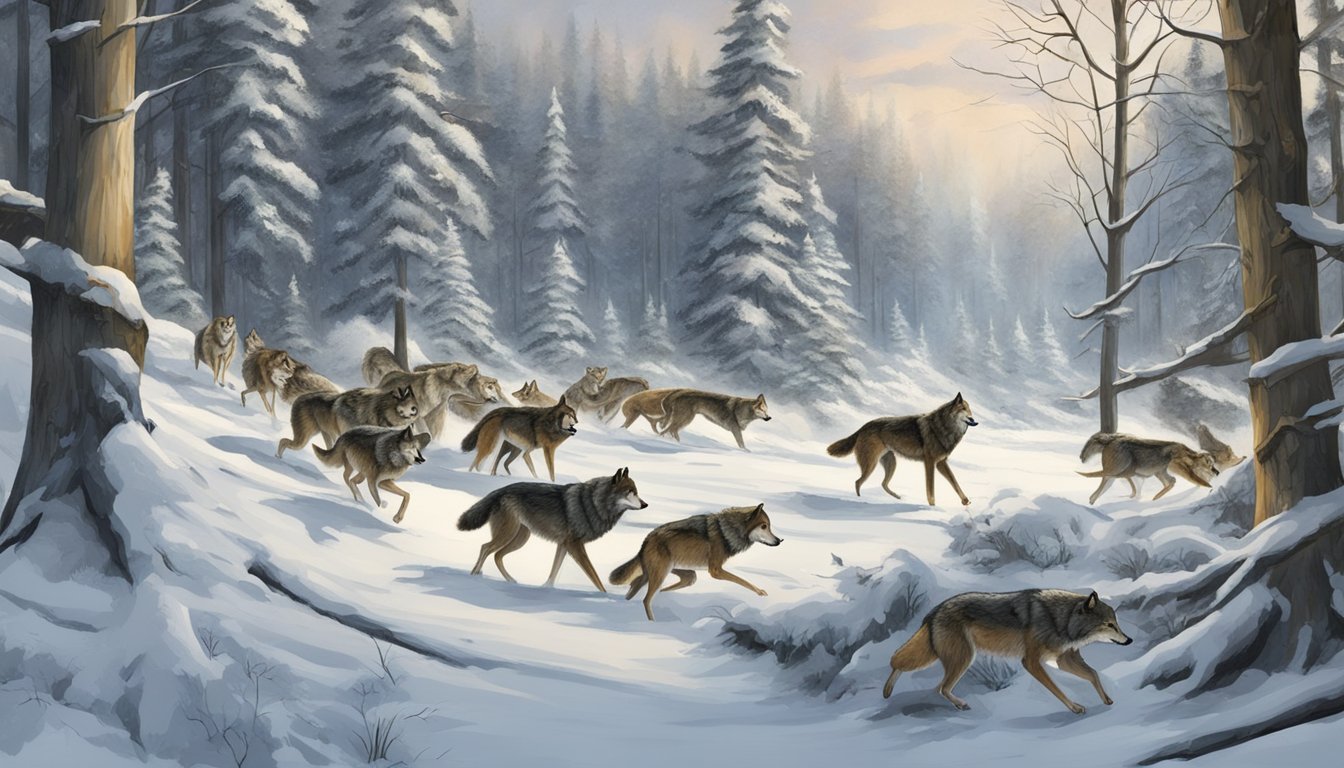Wolf Hunting Seasons
Regulations and Best Practices
This Article is Part of Our Guide on Hunting Seasons for Over 70 Common Game Species
Wolf hunting is a regulated activity in the United States, with each state setting its own rules and seasons for hunters. The objective is to manage wolf populations while maintaining ecological balance and addressing conflicts with human interests. Seasons vary widely by state, but they typically fall between fall and spring to align with the life cycle of wolves and ecological considerations.
In some states, like Montana, the wolf hunting season can extend from September to March, with specific periods dedicated to different hunting methods. For instance, there is an archery-only season preceding the general rifle season. Wisconsin's law specifies an annual season commencing on the first Saturday in November and concluding at the end of February. These regulations are designed to sustainably manage wolf populations while providing recreational opportunities for hunters.
Wolf hunting methods and permitted seasons reflect ongoing wildlife management efforts. States adapt their regulations to balance the needs of the species with those of the ecosystem and human populace. As such, hunters must stay informed about current laws and obtain the necessary licenses to participate in wolf hunting activities.
Wolf Hunting Regulations
Wolf hunting regulations are critical in maintaining ecological balance, ensuring the sustainability of wolf populations, and allowing for controlled wildlife management. These regulations are shaped by federal and state laws and consider both preservation and public safety.
Legal Framework
The legal framework governing wolf hunting in the United States largely falls under the Endangered Species Act (ESA). Wolves may be delisted from the ESA, which allows states to manage wolf populations and establish hunting seasons. When delisted, they are managed by state wildlife agencies which set forth specific regulations and laws.
Season Dates and Bag Limits
State wildlife agencies define specific season dates and bag limits, which can vary significantly:
Montana: Wolf hunting season is typically from September 15 to March 15, with an archery-only season occurring from September 3 to September 14.
Wisconsin: Hunting and trapping seasons are contingent on the wolf's listing status. When legal, the state establishes dates and quotas.
Minnesota and Michigan: Both states have frameworks in place that could permit wolf hunting if federal protections are lifted.
Permits and Licenses
Hunters must obtain the appropriate permits or licenses to legally hunt or trap wolves. Requirements vary by state but generally include:
General Hunting License: Typically required for hunting wolves.
Trapping License: Required for trappers, often with additional training or certification.
Special Permits: Some states may require a special wolf hunting permit accessible through a lottery or draw system.
Hunting and Trapping Methods
States may permit various methods for hunting and trapping wolves, each with specific regulations to ensure ethical practices:
Baiting: Allowed in some states, with restrictions on types and placement of bait.
Calling: Electronic or mouth calls may be used to attract wolves within shooting range.
Traps: Certain traps are legal, subject to state regulations on type and use.
Hounds: The use of hounds can be permitted with restrictions on chase and take.
Archery: Archery seasons typically precede general hunting seasons, allowing the use of bows and arrows under specific regulations.
Wolf Population and Conservation
Wolf populations across the United States are the focus of intense management efforts due to their impact on ecosystems and human activities. Conservation measures are essential for ensuring their survival, particularly for species that have been on the brink of extinction.
Species Monitoring
Effective conservation begins with diligent monitoring. Gray wolves, for instance, are tracked frequently to determine population dynamics and to assess the success of recovery programs. Recent technology such as GPS collars and remote cameras aids in collecting real-time data on wolf numbers and movements, which informs management decisions.
Habitat and Prey Interactions
Wolf populations are closely tied to the availability of prey species such as deer, elk, and moose. The interaction between wolves and their prey is a key natural process that shapes ecosystem health. On the other hand, wolf predation on livestock is a concern and necessitates a balanced approach to predator management to mitigate conflicts with humans.
Endangered Species Considerations
Some wolf species such as the gray wolf and the Mexican gray wolf have been listed as endangered, triggering federal protections. Conservation efforts must consider the delicate status of these species, accounting for human-induced mortality, which can significantly alter population stability. Recovery programs often include measures to protect these wolves from excessive hunting and human-related deaths.
Hunting Preparation and Education
Before embarking on a wolf hunting venture, it is crucial for hunters and trappers to be well-prepared and educated. Mastery of safety regulations, understanding of proper equipment use, and proficiency in hunting tactics are essential for a successful and responsible hunt.
Hunter Safety Courses
Hunter safety courses are fundamental for anyone looking to engage in wolf hunting. These courses cover vital aspects such as human safety, ethical hunting practices, and local wildlife regulations. Participants receive instruction from experts in the field, aiming to preserve human life and wildlife conservation. Hunters learn the use of various hunting tools, including archery and firearms, and methods like calling and stalking.
Key Topics in Hunter Education Courses:
Ethical hunting practices
Safe firearm and archery handling
Wildlife conservation laws and regulations
First aid and outdoor survival skills
Trapper Education
Trapper education courses are critical for trappers, focusing on safe and humane trapping methods. Trappers gain knowledge on the most effective practices, including trap setting, species-specific baiting, and the use of hounds. The courses also emphasize on following state and federal traps and bait regulations to ensure the safety of both the trapper and the animal population.
Essential Elements of Trapper Education:
Proper use and maintenance of traps
Techniques to avoid non-target catches
Humane and ethical trapping standards
Legal requirements for trapping in various jurisdictions
Equipment and Tactics
Selecting the correct equipment and understanding the best tactics for wolf hunting can greatly enhance the excitement and success of the hunt. Hunters use a variety of equipment including bows, rifles, and traps. Knowledge of wolf behavior and habitat is leveraged to strategically use callings and work with hounds for tracking. Efficiency with tools and methods are underscored for respecting the prey and preserving the integrity of the hunt.
Hunting Gear & Techniques:
Firearms: Selection based on legality and personal comfort.
Archery: Skills in bow hunting for a silent approach.
Traps: Understanding of setting and placement.
Callings and Decoys: Methods to lure wolves effectively.
Habitat and Geographic Distribution
The geography of the wolf populations and the seasonal variations play a crucial role in determining the structure and timing of wolf hunting seasons across different regions.
Wolves in the Lower 48 States
Gray wolves primarily reside in public lands and remote wilderness areas within the Lower 48 states, especially in regions where natural habitats like dense forests and proximity to lakes are abundant. In states like Wisconsin, Minnesota, and Michigan, wolves often den in secluded areas and form packs that are active even during the winter months. When they emerge in spring, wolf packs utilize public lands as well as venture onto private property, which can sometimes lead to conflicts with landowners.
Public Lands: Critical for conservation, offering safe habitats
Private Property: Potential human-wolf conflict zones, especially in rural areas
Regional Wolf Seasons
Wolf hunting seasons in the Lower 48 vary significantly by state and are influenced by wolf population sizes and distributions. In states like Minnesota and Wisconsin, wolf hunting is a controversial subject, with seasons being influenced by legal challenges and public opinion. Seasons in Oregon and Idaho reflect efforts to manage wolf populations and, more recently, to address increasing wolf-human interactions.
Oregon: Managed seasons with considerations for conservation
Idaho: Reflects a balance between wolf population control and public safety
States that conduct wolf hunting often gather population data to inform and adjust their management strategies. However, accurate data collection is challenging due to the timing of seasons and methods used.
Ethical Considerations and Public Opinion
Ethical considerations and public opinion play significant roles in shaping wolf hunting seasons. These facets interlink with how humans view wildlife management, conservation efforts, and hunter engagement within communities.
Human-Wildlife Conflicts
Human-wildlife conflicts arise when wolves pose direct threats to livestock, leading to complex ethical situations. Regulations allow for controlled wolf hunts to mitigate these conflicts. However, there is debate over the effectiveness of hunting as a long-term solution. Advocates suggest targeted removal of problematic wolves can safeguard livestock, while opponents argue for non-lethal measures and question the morality of killing wolves as a punitive response.
Hunting's Role in Wildlife Management
Hunting is sanctioned by wildlife management agencies due to its potential to balance wolf populations with ecological carrying capacities and reduce species' overbrowse on public lands. The natural regulatory effect hunters provide can aid forest regeneration and the protection of other wildlife species, such as elk or deer, which might be overpredated by unchecked wolf populations. The ethical stance on hunting often hinges on its justification as a tool for conservation.
Community and Hunter Engagement
Active participation by communities, particularly those living near wolf habitats, is vital. Hunters often partner with management authorities to monitor wolf populations and track conservation outcomes. Their involvement is instrumental in achieving scientifically-informed and ethically responsible wildlife management practices. Public input is frequently sought by wildlife commissions to shape hunting regulations that are viewed as equitable and necessary by those directly affected.
Legal and Seasonal Challenges
In addressing the complexities of wolf hunting seasons, stakeholders must contend with fluctuating regulations and the dynamic challenges presented by weather patterns and terrain. Accessibility concerns also play a significant role in both the execution and management of these hunting seasons.
Navigating Variable Regulations
Regulations governing wolf hunting involve an intricate web of laws at the federal, state, and Department of Natural Resources (DNR) levels. These laws are subject to change due to legal challenges and shifts in conservation statuses. For instance, after wolves were placed back on the Endangered Species List in 2014, wolf hunting was halted. Subsequently, temporary injunctions have further complicated the legal landscape, with wildlife advocacy groups filing lawsuits that argue for the illegality of hunts, citing insufficient management plans and regulation breaches.
Weather and Terrain Impact
The success and safety of a wolf hunt are heavily influenced by seasonal weather conditions, which can vary greatly. In winter, hunters may face frozen lakes and deep snow, while spring might bring unpredictable thawing conditions. Terrain challenges such as navigating dense forests, hills, and rural expanses are further compounded by natural events, making each hunting season distinct and requiring adaptive management strategies.
Access and Accessibility Issues
Access to hunting areas is governed by the availability of public land versus private property. Factors such as an interactive map's accuracy and up-to-date information play crucial roles in determining accessibility. DNR management often provides these resources to help hunters identify legal hunting grounds. However, physical accessibility can still be hindered by natural barriers or the conditions of the terrain — a factor that varies from region to region and season to season, particularly when hunters must cross challenging landscapes like steep hills or navigate around bodies of water that may be frozen or flooding during winter and spring, respectively.
Post-Hunting Practices
After the close of a hunting season, certain mandated practices by wildlife agencies ensure sustainable management and respect for the harvested animals. These include accurate harvest reporting, careful trophy handling, and the use of the animal for culinary purposes, aligning with regulations and ethical hunting standards.
Harvest Reporting
Harvest quotas are critical in managing wolf populations. Hunters are typically required to report their harvests, providing wildlife agencies with data to monitor wolf populations and adjust future hunting seasons. Reports should include specific details such as the date of the kill, sex of the animal, and the location of the harvest. This timely data helps maintain the balance between conservation and hunting interests.
Required Information for Harvest Reporting:
Date and time of harvest
Location (specific zone or area)
Sex of the animal
Method of harvest
Trophy Handling
The careful handling of a trophy — specifically the hide and skull — is a practice that follows the hunt. Hunters are encouraged to clean and prepare these items promptly to prevent spoilage and to allow for any required inspection by conservation officers. Proper trophy handling reflects respect for the animal and attention to legal obligations.
Steps for Trophy Handling:
Clean the hide and skull.
Store in a cool, dry place.
Report and present to officials if required.
Culinary Applications
Utilizing the meat of the wolf is not as common due to the cultural and regulatory restrictions around consuming big game predators. However, when regulations permit, the harvested animal's meat should be processed and used responsibly. This entails proper field dressing, refrigeration, and preparation to prevent waste and honor the spirit of sustainable hunting practices.
Culinary Considerations:
Field dressing to preserve meat quality.
Awareness of local laws regarding the use of wolf meat.
Sharing or donating the meat if consumption is not a personal choice.
Related Hunting Activities
In addition to wolf hunting, there are various activities that hunters may partake in to maximize their outdoor experience. These range from pursuing other big game to engaging in combined fishing and hunting trips, as well as participating in predator control to maintain ecological balance.
Big Game Opportunities
Big game hunting is a significant pursuit for many hunters seeking excitement and challenge. Typically, this includes the following species:
Antelope: Known for their speed, antelope present a unique challenge in open environments.
Bison: As one of North America's largest game animals, bison hunting requires both permits and a respect for this symbol of the prairies.
Black Bear: Pursuing black bears demands a deep understanding of bear behavior to ensure safety and success.
Grizzly Bear: With additional regulations and safety measures, grizzly bear hunting is an intense endeavor that contributes to managing populations in certain regions.
Fishing and Hunting Combinations
Combining fishing with hunting activities offers diverse outdoor experiences. Here are some common pairings:
Hunting and Freshwater Fishing: Many hunters pair duck or deer hunting with fishing in nearby lakes and rivers to enjoy everything the habitat has to offer.
Big Game and Fly Fishing: After a day of tracking big game, relaxation can be found in fly fishing in local streams, often within the same region.
Predator Control Practices
Predator control practices involve regulated hunting activities that help in maintaining the ecosystem's balance. These include:
Coyote Hunting: This is a common control practice, as coyotes can have significant impacts on other wildlife populations.
Wolf Management: Controlled wolf hunting, as discussed in the wider scope of the article, is a crucial part of predator management in several U.S. regions.
By participating in these activities, hunters contribute to conservation efforts and the regulation of wildlife populations, ensuring a balanced ecosystem.









